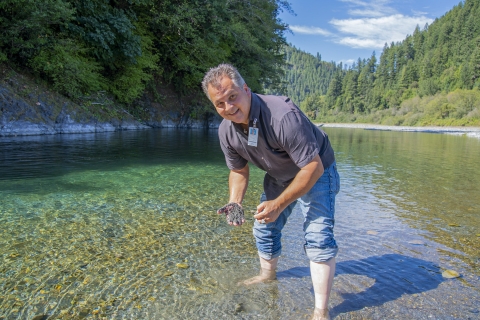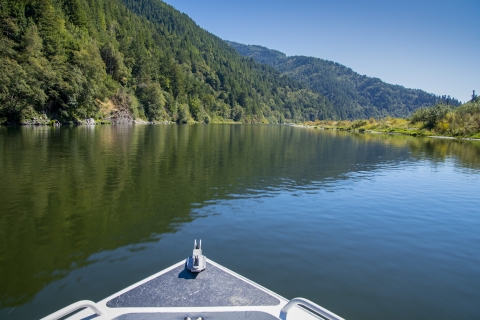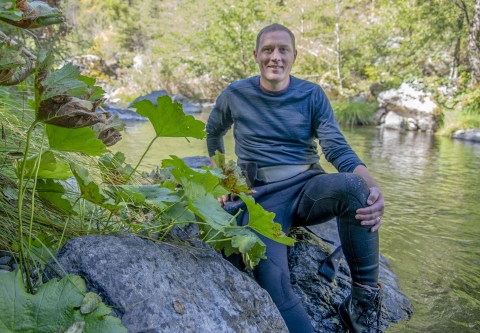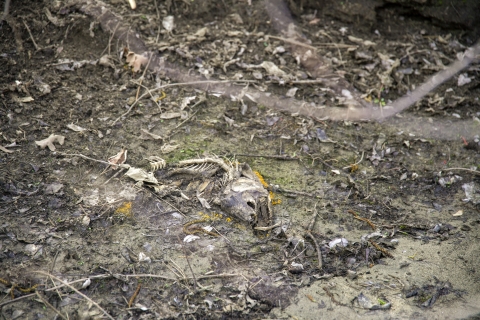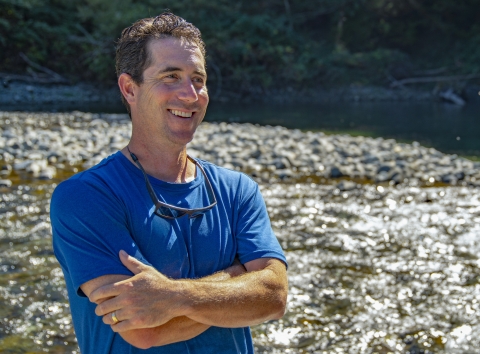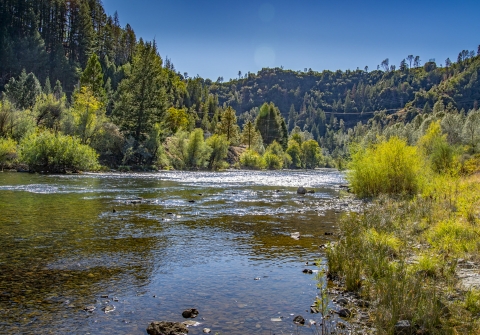In northern California, springtime is marked by wildflower blooms, bird migrations, swollen rivers, and the return of the first salmon of the year to the Klamath River – spring-run Chinook salmon.
This genetically-based life history strategy of Chinook salmon is not only critical to the genetic diversity of the species and the economy for fishing, but also provides a vital source of food and other cultural value for indigenous people of the Klamath Basin.
“You can ask any tribal member right now, and they will tell you that one spring salmon is worth 8-10 fall fish. They are that valuable. If I had two jars sitting here, you could see on the spring fish an inch of red oil and the fall fish sitting right next to it with almost no red ring,” said Keith Parker, a Yurok tribal member and biologist referring to the fat content.
U.S. Fish and Wildlife Service biologist Damon Goodman agreed. Adult spring-run Chinook salmon do not feed while in the river, but rather rely on high-fat content that provides energy reserves while holding in deep pools over the long summer months. “This also makes spring-run arguably the most prized of all fish to eat in the Klamath River,” he said.
The value of spring-run Chinook salmon is more than just sustenance for tribes.
“We are fish people, and the river is the central focal point of our culture,” said Parker. “Religion, culture, language, food all evolve synchronously as it does in any society. When you remove any one of those from the equation it has huge impacts on the other things.
“When you look at our community, the river is our grocery store. We eat and survive off the river. In fact, we don’t have a grocery store in this community. A lot of people don’t understand; they will say if you don’t have salmon this year, just go buy hamburger. The problem is, we know from science that no matter where you are from, that over thousands of generations of human beings become adapted to a specific regional diet. So for tens of thousands of generations, we ate a lot of spring salmon with high lipid content.”
The value of spring-run Chinook salmon, however, goes even further than that, when considering their genetic make-up.
Dr. Andrew Kinziger, fisheries department chair for Humboldt State University said different life histories of the Chinook salmon could help the species survive into the future.
He believes in the “portfolio effect,” (from the investment world) where one diversifies their investments to buffer against significant losses in one area. “The portfolio effect is also thought to apply in natural settings where we see a diversity of life histories in Chinook salmon in spring and fall types and in steelhead with summer and winter eco-types,” said Kinziger. “All these different life histories serve to build a portfolio that can buffer against environmental change. You can have one year when one eco-type doesn’t do well, but another eco-type might do better, so that buffers against poor performance of any one of the eco-types.”
Dr. Tommy Williams, a research fisheries biologist with the National Oceanic and Atmospheric Administration agrees with the idea of the portfolio effect, adding that habitat diversity plays a critical role also.
“The diversity of habitat types, both physical and ecological is critical,” said Williams. “The diversity of habitat conditions and processes allows for the expression of a range of life-history types. Restoring connectivity within a watershed like the Klamath River provides access to historically accessible areas upstream of the dams. Additionally, dam removal reduces constraints on physical and ecological processes, allowing for a more dynamic and diverse habitat portfolio. Large restoration projects like the proposed removal of four dams on the Klamath River are at the scale needed to start restoring the environmental portfolio required for diverse fish communities and expression of a range of life-history diversity.”
One difference illustrating that diversity is the spring-run’s ability to spawn farther upriver and earlier in the season than their fall-run counterparts in rivers where no passage barriers exist. This creates a degree of both spatial and temporal segregation between fish of each run. Reliant on high-quality habitat, including cool water temperatures throughout the summer and deep pools that provide cover from predators, spring-run enter the river sexually immature and spend time holding and developing reproductive gametes in preparation to spawn.
Their ability to construct nests (or redds) beginning in September (typically earlier than fall-run Chinook salmon), leads to the river bed being rearranged and an altering of the shape of the river bottom, thus improving the habitats for other fish and bugs.
After spawning, they die, leaving their decomposing carcasses, made primarily of nutrients from the ocean, to provide fuel to the productivity of the stream and riparian riparian
Definition of riparian habitat or riparian areas.
Learn more about riparian zone.
The Klamath River Basin was once the third largest producer of salmon in the United States outside of Alaska and historically spring-run was a primary component of its overall Chinook salmon populations. However, per Goodman, spring-run are now at a fraction of historical levels with natural origin fish being at the lowest levels recorded with less than 700 returning to the Klamath Basin in 2019.
However, hope is not lost and many efforts are underway to improve conditions for natural origin spring-run. “For eco-types such as the spring-run Chinook salmon that are reliant on headwater habitats, restoring access to natal spawning grounds is likely to be one of our most successful restoration approaches,” said Goodman.
One such project is the Klamath River Renewal Corporation, working in cooperation with PacifiCorp, Inc., to take ownership of four dams on the Klamath — JC Boyle, Copco No. 1 and 2, and Iron Gate. This partnership will restore formerly inundated lands and implement required mitigation measures in compliance with all applicable federal, state, and local regulations. The project restores access to an estimated 420 miles of anadromous stream habitats. This would arguably be the largest river restoration project on the planet with spring-run Chinook salmon being a primary beneficiary.
Conservation efforts are also underway to improve fish habitats below dams. “To help with the conservation of spring-run, we are working with our partners to develop and apply creative approaches to streamflow management to improve their chances of survival,” said Goodman. One example Goodman provided was work recently published in the Journal of Ecological Engineering, which proposed an approach to release water from dams in a way that mimics elements of natural flowing rivers.
“We predict this would greatly improve spawning and rearing conditions for spring-run,” he said of the study. “We have also worked with our partners to develop strategies to better manage water temperatures below dams to promote survival of spring-run Chinook salmon through the summer months in areas where they can no longer access their historic headwater habitats. In addition, we closely monitor water temperatures to evaluate the success of these management actions using an adaptive management feedback loop to improve future water temperature management strategies. We are hopeful these efforts will pay dividends in the long-run.”
Restoring upstream and downstream passage for anadromous fishes is a primary focus of the Service’s Fish and Aquatic Conservation Program, through efforts such as the National Fish Passage Program and California Fish Passage Forum.

